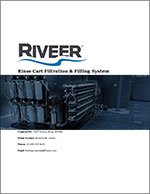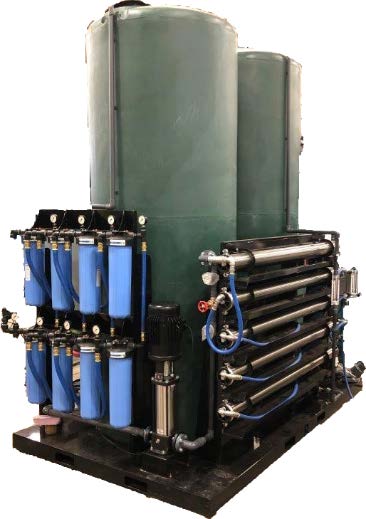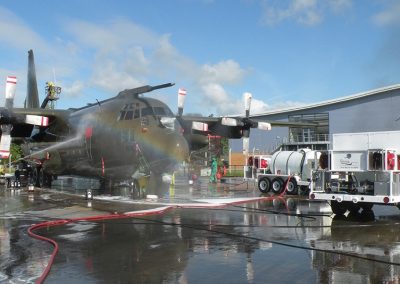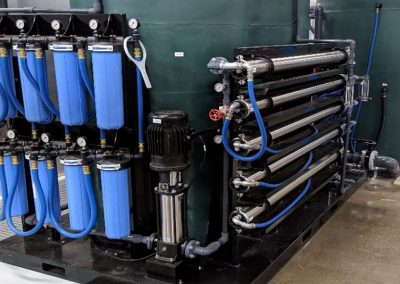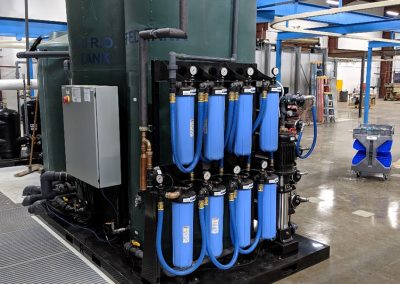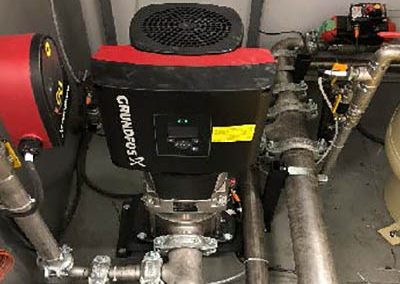Inlet water Filtration System
A simple system that filters your water supply while filling up your aircraft rinsing utility tank.
Inlet Water Filtration System
A simple system that filters your water supply while filling up your aircraft rinsing utility tank.
Consistently fill rinse tanks with deionized ultra-pure water regardless of base water supply quality.
Utilizing a combination of softening, particulate, carbon, and reverse osmosis, the Riveer system accepts base supplied water and targets minerals commonly found in base supplied potable water systems such as Minerals, Particulates, and Salts. Common items added to water to keep it safe and healthy, such as chlorine and fluoride, are detrimental to the corrosion fighting process.
Many municipal water supplies add calcium carbonate to the drinking water supply. This mineral forms a coating on the pipes and prevents lead and other toxins from dissolving from the pipes and creating health problems in ingested by people. While this mineral is important to keep people safe, it is also one of the biggest offenders which can accelerate airframe and turbine corrosion, and is a prime target of the inlet water treatment system. Removing these minerals from the wash and rinse water makes the system exponentially more effective in the battle against corrosion.
Effectively removing corrosion-causing potential from aircraft requires compliance with aircraft OEM and NAVAIR 01-1A-509 water quality standards for aircraft cleaning. In order to comply with these standards, airframe rinse and engine wash operations are required to use clean water with less than 500 parts per million of Total Dissolved Solids (TDS). Many domestic water supplies in the US have higher solids content than this and thus require pre-treatment for use on aircraft.
However, systems such as Aircraft Rinse Carts are commonly deployed for flight line rinse operations with water limited in quality due to poor base water quality. Base water quality varies widely between each installation and often fails to meet water quality standards set forth in TM 1-1-500-344-23-2, TO 1-1-691 and NAVAIR 01-1A-509 standards for aircraft cleaning. Base water that does not meet or exceed water quality standards can decrease effectiveness and introduce new corrosion causing contaminants to airframes and engines such as Iron, Chlorine, and Salts commonly found in potable water sources.
System Specifications:
- Auto fill for unattended fill-up, fill an ARC in under 10 min
- Processed Water Holding Capacity: 2300 gallon fill 2 ARC without replenishment
- Production Rate: 10 GPM allows 100 minute recovery rate from empty tanks
- TDS and pH monitoring ensure water quality and makes record keeping simple
- 6” touch screen with auto and manual features
- 100 GPM, low psi transfer fill pump with Variable Frequency Drive (VFD) to protect receiving equipment such as Aircraft Rinse Cart tank from over pressurization
- Grundfos Variable Frequency Drive (VFD) RO pump
- FRP RO membrane housings
- 20 GPM industrial scale water softener
- 5 Micron dual gradient filter array
- 15 GPM Granular activated carbon filter
- Run dry protection
- NEMA 4 electrical construction
- Fully powder coated steel skid frame with 4 stage Zirconium pretreatment process including zinc rich epoxy powder primer, with UV/oil resistant polyurethane powder topcoat.
- Automatic shut-down for low pressure, high temp, low Hz or high Hz
- Full protection circuitry for pumps, motors, and generator
- Perfect water for Turbine Flush, AC flush, or any high purity needs § 208, 380, 400, and 480V/3PH 30A versions availabl
Onboard Rapid Fill Pump for Rinse Cart
Depending on the availability of a hydrant fill, most locations can only fill the Aircraft Rinse Cart with a garden hose connection providing a fill rate of 5 gallons per minute (GPM) for a total fill time of 200 minutes. When compared to the Aircraft Rinse Cart’s ability to spray up to 20 GPM of water, the rinse cart will inevitably outrun the replenishment of an alternating rinse cart by 150 minutes creating a waiting line at the fill station. Filling the tank in 10 minutes un-attended will allow each rinse cart to rinse 3 more aircraft per day.
The Riveer Aircraft Rinse Cart Filtration & Filling System eliminates the “waiting line” dilemma by providing a fill rate that exceeds both the standard fill rate from a garden hose as well as the rinse cart’s output rate. By providing a fill rate of 100 GPM, each rinse cart will fill in 10 minutes or less eliminating the ability for the next rinse cart to “spend” water quicker than the next one is being filled. Adding a fill time reduction of 190 minutes and the elimination of a potential “waiting line”, the transfer pump on the filtration & filling system affords operators near continuous rinsing during the day while adding the correct water quality.
The fill pump operates with a Variable Frequency Drive (VFD) that maintains a maximum pressure of 25 psi with pressure controlled auto-shutoff to protect the Aircraft Rinse Cart tank from over pressurization.
Aircraft Safe Water Quality & MIL STD Compliance
The Riveer Rinse Water Filtration & Filling System delivers Ultrapure water to operators in a 2350 gallon package. Base water feeds the system through a 1” line and discharges through a small drain, even an existing trench drain.
In order to achieve a rinse water quality that not only meets TM 1-1500-344-23-2, TO 1-1-691, and NAVAIR 01-1A-509 water quality standards of less than 500 ppm Total Dissolved Solids (TDS), but also exceed this quality by over 10 times to a TDS level below 30 ppm with the worst feedwater–a 98.5% reduction in TDS is minimum reject rate in operation.
While the standard water quality requirement calls for less than 500 ppm of TDS, corrosion is best fought with the cleanest water possible. Removing up to 100% the amount of solids and contaminants in the rinse water increases the absorptive property of that water. This results in a rinse water that is more effective in grabbing contaminants and pulling them off the airframe during rinse operations rather than simply running across the airframe and over contaminants or worse, adding salts in the form of chlorine and residual salts in the tap water.
Filtration Processes
Stage 1: The first stage in the filtration process involves a dual gradient filter to capture larger suspended solids ahead of the water softener.
Stage 2: Ion exchange through a 20 GPM water softening system is the second stage for water treatment. Using a water softener, the second stage targets dissolved minerals such as Calcium, Magnesium, Iron and other micro abrasives commonly found in base and city water distribution systems.
Stage 3: Granular Activated Carbon: The third stage in the water treatment process targets Chlorine through adsorption with Granular Activated Carbon filter media. Removing chlorine from the rinse water serves two purposes, with the first being to protect aircraft from receiving chlorine throughout the rinse process risking increased corrosion. The second purpose of this stage is to protect the health of the Reverse Osmosis membranes in the final stage of filtration.
Stage 4: Reverse Osmosis: Following carbon filtration, the final filtration stage includes a 10 GPM Reverse Osmosis system to target and remove salts from the rinse water. Salts are the most threatening to aircraft rinse operations as they are highly corrosive. The very purpose of aircraft rinse operations is to use pure fresh water to remove salt from the aircraft’s surface that have been deposited during maritime flight or coastal stationing.
Water Holding
Once rinse water is filtered, it is held for distribution in (2) 1150 gallon vertical holding tanks for a total rinse water storage capacity of 2300 gallons. In these tanks, the rinse water is injected on a timed basis with Ozone to eliminate organic growth within the rinse holding tanks. An onboard Ozone generator provides Ozone production with zero consumables.
Water level in the rinse water holding tanks can be indicated by the level indicators on the side of the tank along with a clear site tube.

